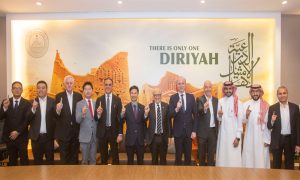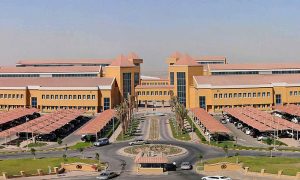The tech revolution
Jordan’s BIM masterplan
In June this year, the Jordanian government signed an agreement to establish a national buildingSMART forum. Tasked with improving efficiency, extending value chains and cutting waste as Jordan’s development gathers pace, The Big Project speaks to the BIM enthusiasts modernising the industry
It began in North America in 1995, founded by an alliance of North American organisations that collectively decided it was literally time to start building smart.
With a remit to achieve nothing less than revolution within the construction industry, buildingSMART went worldwide and forums were soon established in Australasia, Asia, Europe and North America; then in June the Jordanian government became the first in the Middle East to sign an agreement to initiate its own national forum.
Providing a platform to discuss, develop and promote the application of Building Information Modelling (BIM), the new forum is part of buildingSMART ME; which has thrived in the UAE since 2009.
The agreement was signed between Jordan’s Ministry of Public Works and Housing (MPWH) and the Jordan Engineers’ Association (JEA) with buildingSMART MENA and India (buildingSMART ME) and the BIM Journal. “The Jordanian construction industry will see significant improvements and cost of projects going down with the standards and best practices buildingSMART ME will bring.
“As a non-profit and neutral organisation, we will continue to reach out to other governments and decision makers across the region helping them realise the benefits of BIM,” says says Tahir Sharif, founding president of buildingSMART MENA and India.
The fully functional and self-funding forum, aims to align the work of architects, engineers, contractors, manufacturers and the building owners and operators to enhance communication and share information.
In additional to the localised benefits for Jordan, it’s a seminal point for the adoption and promotion of BIM in the Middle East, and each of the organisations taking the “BIM oath” will have an important part to play in achieving the goals set out.
The number one priority – to raise awareness of the use of BIM in the country – will primarily be supported by the BIM Journal, which will now be distributed to the 90,000 member JEA.
Other stakeholders involved in the formation of the new forum include Jordan University of Science and Technology (JUST), MID Contracting Company (MIDCC), El-Concorde Contracting Company (ECC) and Amman Consulting Office.
Right from the start
“Traditionally, building information is generated during each project phase and often re-entered or produced during hand offs between phases and organisations,” says Sharif.
Explaining that by the end of most projects the value of information in such a format depreciates due to its poor reflection of the finished project, he maintains the practice of collating 50-100 boxes of nearly 1000 drawings is “unmanageable”.
“At Tekla we know how fragmented and complex construction projects can be,” said executive vice president of Tekla Risto Räty; as buildingSMART supporter the company helped establish the MENA and India chapter and offers its BIMSight on free download.
“We also know that building information models have a way of making reality seem much less complicated. We will be there for our existing and potential customers each year with more and more organized BIM software and the most devoted technical support in the industry to enable them collaborate across all organisations to make great deliverables for building and construction.”
“Owners can use a BIM model to quickly populate and update FM databases, often saving on reduction in labour needed to enter information manually. Building components and assemblies are associated with facility information and used to support critical analyses such as condition assessment over time and the need for preventive repairs,” he says.
Yet the principle doesn’t end at the beginning; BIM isn’t just about getting construction right, it potentially prolongs the entire lifecycle of a project.
“Facility managers can use these visually intelligent models to determine the impact of retrofit or maintenance work,” Sharif continues, adding: “Preventive and routine maintenance tasks can be planned without disruption to operations because the facility manager has a live visualisation of the areas affected during the maintenance.”
BIM also allows such scenarios as emergency evacuation to be considered as early as the design phase.
“Allowing BIM models to be populated with electronic people simulating running, turning and detecting the nearest exit, allows egress patterns and time required for evacuation to be studied,” Sharif elaborates.
“In the operations phase, owners are performing what-if scenarios of moving people and equipment, analyzing and minimizing energy usage, while operating the facilities virtually.
“Major corporations use feedback from BIM enabled FM systems to guide the design of newer facilities, often benefiting from improved understanding of specific operational requirements,” he adds.
“Once the BIM has been created, designers have more time to think about the options and can change things very quickly,” says Davis Langdon’s global head of Thought Leadership, Erland Rendall.
“If the cost consultants cannot respond to these options just as quickly, they can get behind on the curve and miss out on the opportunity to add value at the time when key decisions are made.
“We are actually setting our ambition out to provide our advice in real-time, as and when changes are made to the model,” Rendall continues.
The software itself is merely a tool used in the implementation of BIM, according to Sahrif, who calls BIM an “enabling technology” with potential to improve communication among business partners, improve the quality of information available for decision making and reduce cost and waste at every stage in the life cycle of the building.
“Technology must be deployed as part of a comprehensive business strategy to be successful,” he deduces.
The survey said
Despite the benefits a recent survey conducted across the GCC and Jordan found familiarity with BIM in the region was “moderate” with only 25% of respondents familiar with the software and only 5% utilising it.
Of those who were using the tool, competency lagged in comparison to Western Europe and the US. The results indicated that a mere 31% of these users were company trained, with 46% self taught and only 9% institute trained.
“Overall the findings represent a market that is optimistic and aware, but inexperienced in BIM,” the report concluded. Based on the survey results, BSAME has launched a training and certification program to help the industry play catch up; training over 200 professionals to introductory standards in the last year.
“BIM is undoubtedly the future of the construction industry and just like health and safety and sustainability have, it will eventually become engrained in the fabric of all construction projects,” predicts Jonathan Lock, structural CAD manager with ARUP.
“Designers are currently leading the adoption wave by implementing the technology and processes of the ‘little BIM’ world that come from a need to meet the challenges of designing better buildings in more efficient and sustainable ways. This world brings incremental benefits to the individuals and groups engaged in BIM practices resulting from continual technology improvements.
“The challenge is expanding this out into the ‘big BIM’ world whereby the whole supply chain is engaged to shift the focus on to the large scale process improvements that will bring about the project wide benefits,” Lock continues, adding that ‘educated’ clients need to drive the need for BIM to take its adoption to the next level, and further suggesting there are three primary barriers to BIM’s adoption.
Observing that levels of both understanding and adoption in the region still vary wildly, regional MD for Gehry Technologies, Lionel Lambourn, says awareness has grown over recent years.
“More and more, we are seeing BIM specifications written into a project’s contractual requirements. When you read these specifications, you notice a general trend of growing sophistication and understanding of the use of BIM; however, we are still in very early days.
“There are still scores of projects currently in construction that could have but do not currently benefit from the use of BIM,” he says, speculating on the causes.
“The barrier is when you have already made that initial investment in time, resources and money, and have implemented what you think is BIM on that first project. Perhaps it’s one year since you invested in BIM and you are struggling to reap the benefits on your project and you start to worry that this whole BIM idea was a mistake. This is where the barrier is.
“Some companies will persevere and work hard at developing those best practices that allow you to truly leverage BIM for a significant return on investment, other companies will find the learning curve so steep that they just slide ride off.
“The thing with BIM is that it requires the development of a well-coordinated set of best practices and a concerted effort at adhering to those best practices in order to see the return— it is not something that magically happens when you take an installation CD out of its box and put it into your computer,” he says.
Jordan: a case study
Weighing adoption rates against the benefits is particularly significant for Jordan; a country reaching a critical period in its development.
“It is important for Jordan to make sure this goes well,” explains Bentley Systems’ industry sales director, Hassan Malki, who is also a board member of BuildingSMART ME and a member of the new Jordan forum. “Utilising BIM across the life cycle of a project is like an insurance policy; it mitigates the risk of going over budget and extending the project schedule; and that’s just in the construction phase. In the operations and maintenance phases it is possible to save up to 10% of operation costs.
“In comparison to its regional neighbours, Jordan is short on financial resources and they don’t have oil, so it’s even more important to make sure that projects are operating efficiently,” Malki adds, drawing reference from Bentley’s own work on projects such as Masdar City and Dubai Festival City, where the company ran projects that demanded integration and interoperability; elements linked by BIM.

Representatives from the Jordanian government, engineers' association and buildingSMART when the agreement was signed
A small country of 89,342 sq km the Hashemite Kingdom of Jordan has ambitions for its future developments and the country’s leaders are showing increased commitment to getting it right first time.
As The Big Project recently reported, this year Jordan enlisted the advice of consultancy firms such as EC Harris, to drive forward the adoption of PPP contracts. The establishment of the national buildingSMART forum is another step in the country’s modernisation.
The Jordanian forum isn’t just a giant leap for the awareness of BIM, it also means This all government projects will have a BIM requirement and the country’s next generation of engineers, consultants and professionals from other industry sectors will be trained in its principles and applications; elements which will form the groundwork for what it is hoped will be its widespread regional adoption.
“The forum is certainly a move in the right direction but the effect of such a declaration is dependent on how actively it is implemented,” asserts Lambourn.
Gehry utlised BIM in various stages of the Guggenheim Museum design and other projects in Abu Dhabi, Qatar and Dubai.
Yet questions still remain: “How will the government enforce this? Will economic incentives be provided by the government on projects that are considering the use of BIM? Will excess levels of construction waste incur steeper penalties?
“These are questions that demand answers with some degree of sophistication from experts who not only understand BIM but the industry and how it is affected by the national and global economic forces that we currently face,” Lambourn continues.
“I imagine the Jordan forum will bring many of the same benefits that we have seen arising from the UAE forum,” says its vice president and Oger Abu Dhabi branch director, Gerard Couturier.
“This includes raising awareness in the construction industry not just of BIM, but of OpenBIM standards and collaborative processes. We also hope to see the emergence of BIM user groups and other forums that encourage the interaction of industry professionals and generally raise the level of BIM competency in Jordan and the broader region,” he continues, adding that the support provided by Jordan’s MPWH and Engineers’ Association is a “bold step”, setting significant precedence in the region.
In addition to Jordan’s young engineers and architects now studying BIM, the country’s “unique” landscape and terrain can benefit from modernised urban planning that will optimise the use of the available land and resources, says Sharif.
“Since BIM is quite new in Jordan, the establishment of the Jordan Forum with the support of government bodies, will ensure that BIM is adopted in the right way. buildingSMART ME is working with the Jordan forum on the BIM Manual, which will streamline the adoption and integration of BIM into the local construction industry,” Sharif explains.

A BIM model will hold all the project information and also allow users and collaborators to see how the building will work
Making the change
Jordan’s isn’t the first government to take the “BIM oath”; buildingSMART has chapters worldwide and support governments and owners in the transition to BIM by helping to create BIM Manuals, BIM Implementation documents and BIM process consultations, that Sharif refers to as “customised solutions to the construction industry in the Middle East”.
“The industry needs a leader and there is nothing better than a government body to take that to the industry,” Lock continues.
“The government is looking at the lifecycle of a project and with BIM they can reach the desired goals for sustainability as well as ensuring the operational management of the facility is best controlled as costs implications can be seen in the early stages of planning,” he explains.
“BIM has been identified by Singapore as one of the key technology drivers to raise construction productivity significantly,” says Cheng Tai Fatt, director of the corporate development division for the Singaporean government’s building and construction authority.
“In addition, it has been demonstrated through the use of BIM that there will be significant manpower savings in terms of producing will be a mandatory requirement for regulatory building plan approval in Singapore and a centre for construction IT has been established to support the transition.
“During the early years, the tools then were not that matured and take-up rates were low. Recent years have seen the global use of BIM and we started to explore this in 2009 with pilot projects. We have since opened up the CORENET e-submission system to accept architectural submissions for regulatory approval in January 2010, followed by the acceptance of structural and MEP BIM e-submissions in April 2011,” Fatt continues.
Incentives schemes will also be introduced to subsidise the procurement of hardware, software, training and consultancy; ensuring no firm is left behind. Singapore also hosts a buildingSMART week, scheduled for later this month, when the International User Group and International Technical Committee will meet.
In Finland the process began in 2007 when Senate Properties was the first firm to demand BIM from Finland’s AEC industry.
Today, Senate Properties’ chief advisor and architect, Kari Ristolainen, speaks openly about the benefits BIM brought during the 50 plus projects the company successfully completed with the technology; including the flagship Music Centre building in Helsinki, which opened last month.
“As AEC and FM clients, along with governments, strive toward achieving open standards in the industry, specifically in BIM through the planning and design component, and in ‘smart buildings’ technologies, for example the operations component, they will foster innovation,” Ristolainen comments.
Saying it can advance productivity, efficiency, quality, and sustainability through energy use reduction in both construction and operation, Ristolainen adds that BIM improves the built environment for end users, clients and stakeholders.
“We hope that governments will support, to all extents legally and practically possible, the use of open BIM and SBT solutions in public construction works,” he adds.
In the UK the government’s chief construction advisor, Paul Morrell, has set a series of challenges for companies operating within the built environment: to reduce building costs by 20%; cut carbon emissions; and embrace mandatory 3D BIM across all government projects within five years.
“Unfortunately, despite the publicity it is receiving, the advantages of BIM are not always obvious. Yet, in reality, they are numerous and undeniable,” responds Causeway divisional director of Tradex, Tim Cole.
“The models that go ahead are clash-free and far less likely to encounter problems during the construction process,” Cole adds, referring to the case of Capita Symonds where in 2006, £500,000 was saved through the implementation of BIM on Costain’s £30m PalaceXchange. It’s not just those already in the BIM circle that are singing its praises.
In July ProMedia, a subsidiary company of Omnix International in Qatar, advised architectural and engineering consultancy MZ & Partners to utilise three BIM programmes during the execution of its Qatar projects. Valued at QR 3b, the projects utilise BIM to meet the Qatari government’s mandate towards sustainability.
“Construction projects today waste a lot of money in the constant revision of electrical drawings, HVAC and plumbing plans and other drawing designs due to clashes in measurement and other factors,” comments general manager Fawzi Ismail, who adds that competitive advantages can prompt production time savings in the region of 60%; four to six weeks off the design process. The company’s pool of architects and designers are now able to link the structural and MEP models directly into the architectural model to see all components together.
More than a bottom line
As the world’s fragile economies slowly recover, BIM’s advocates say timely implementation does not only make sense in terms of ROI, but also in terms of time management; implementing and training staff before new tenders are announced will ensure they’re not only on their marks, but ready for the starting whistle.
“BIM, done properly, is invaluable and has proven itself again and again – the savings in design, work sequencing and change management benefit both the professional team and contractor and ultimately the client,” says general manager of software providers CCS Gulf, Ian Hauptfleisch.
“Anyone shown BIM cannot deny the benefits but it will take some time to replace the traditional methods.
“The Bill of Quantities is still the widely accepted contractual document and forms the basis for pricing, costing and payment of a project. Unfortunately the relating of a BIM model to a bill of quantities and vice versa is not a simple task, without prescribed standards and formats,” he adds.
To BIM or not to BIM?
While the region may attract the cream of the world’s construction crop, it doesn’t attract the cream of its standards; a situation true to elements from health and safety to sustainability.
While Couturier maintains it will be the role of buildingSMART to remedy the lack of regulation surrounding stringent BIM requirements, he says the support of authorities such as MPWH and JEA will be vital.
That’s not to say the task will be an easy one, in light of the significantly technophobic attitudes many have observed.
Using the lack of automation across the industry as an example, Causeway’s business development manager Phil Auguste and COO Paul Madeira, say it isn’t a regional culture but an industry one.
“Electronic trading, digital signatures, automated document managements; it’s not utilised. Over here it’s six signatures and a stamp and paper is good,” comment Auguste.
“Automation is part of a process,” says Madeira. “If you look at the way aviation is developing EGate works with no interaction and the hospitals here are far more advanced than any I have seen in Europe. In certain industries technology is leading the way.
“It’s funny because now we can apply for staff visas online; you complete the form but then you can’t submit it online, you have to print it. Then you stamp it and it goes back into a manual process, yet that’s still a monumental shift,” he continues.
Noting that it isn’t merely a fear of technology, or even commitment to invest, that prevents its widespread adoption in the industry, both agree the real resistance to change stems from the economics of employing huge teams rather than paying a one off price to purchase the technology that will replace that team.
“I believe contractors will adopt BIM quicker than anyone else,” Madeira predicts. “As they move to fixed price jobs, they will take the manual model and make it into a 3D model to become more efficient, because they want to make sure their revenues are protected,” he adds saying there is particular appeal in design and build contracts.
“For a successful implementation, business leaders should examine their needs and select products and services to meet those needs,” advises Sharif.
“Cost and benefit analyses will assure them that the investment will result in increased revenue and profit. They should then use the knowledge gained from measuring performance to adjust their strategy,” he concludes.
In October 2010 Gerard Couturier was elected Vice Chairman of the UAE forum of BuildingSMART ME; he confirmed his commitment with the following statement:
“I am committed to the development of Building Information Modelling in the region and to the promotion of BuildingSMART ME as a principal industry resource for OpenBIM standards
and processes. “I support the vision and mission of buildingSMART ME and will leverage my experience and engagement with the Middle East AECOO industry to encourage a truly regional response; promoting collaboration, innovation, sustainability and the pursuit of worldclass standards.
“Engaging regularly with all sectors of the industry, from government bodies to developers, from contractors to sub-consultants, I believe I am well positioned to respond to the needs of the broad membership base and to contribute to the success of buildingSMART in the region.”
Cheng Tai Fatt, director in Singapore’s government building and construction authority: “Leveraging on IT tools such as BIM is one way to raise productivity and improve process efficiency.
“The use of such tools will also level up the professionalism of the industry and raise competency and capability across the construction value chain.
“Government and authorities who did not leverage on such tools will be missing out on a great opportunity to transform the construction industry from one that is deemed to be dangerous, dirty and demanding to one that will be seen as professional, progressive and productive.”
Jonathan Lock, ARUP Taskforce:
“Think there are three main barriers that still need to be resolved or at least improved before adoption of BIM becomes consist throughout the industry. Interoperability and data exchange is perhaps the biggest current issue. The sharing of information between these different models — is critical to the collaborative use of BIM, by assuring that each model consistently represents the same building. However, current technology does not yet allow seamless coordination between different BIM applications. The use of multiple models undermines the collaborative use of BIM and prevents project parties from reaping the full benefits of BIM’s capabilities.
“Risk Management with potentially design teams that may have a policy of not sharing BIM information as a risk management strategy, particularly in the context of data accuracy, this then leads onto the ownership of BIM models and who will inevitable be responsible. People, Training and skills – The lack of knowledge and training across the supply chain is a major barrier, with training critical to increasing BIM implementation.”
What is BuildingSMART?
In its own words, buildingSMART ME, incorporated in the UAE, is part of a global alliance for interoperability, a not for profit organisation, promoting BIM as a means to improve efficiency and sustainability in construction for more than 10 years.
BuildingSMART ME works to develop and deploy internationally recognized standards for processes and technologies, that will improve interoperability and communication between all project stakeholders, throughout the entire life cycle of a construction facility.
Groups all over the world are forming new buildingSMART regional alliances that are driving
their local markets towards greater building efficiencies and innovations.
Building Information Modelling software is beginning to streamline the design, construction,
and operation processes.
Teams are using the open international standards developed by buildingSMART for information exchange in projects worldwide. However, today’s buildings still aren’t good enough. Unlike other major sectors of the world’s economy, the construction industry has failed to take full advantage of the opportunities provided by technology to achieve new efficiencies.
Manufacturers, for example, can produce and ship their products much faster and less
expensively than they could a decade ago. Meanwhile, construction methods have improved only marginally over the past century. If you look at photographs of buildings being built 100 years ago, you will find scenes remarkably similar to those we see now on construction sites.
Though local conditions place different demands on buildings, the need to develop better buildings knows no geographic boundaries. Today, this demand is as urgent in the fast-growing cities of the Middle East.
The organisation has chapters in:
Australasia
Benelux
China
Italy
Japan
Korea
Singapore
North America
UAE
UK
























